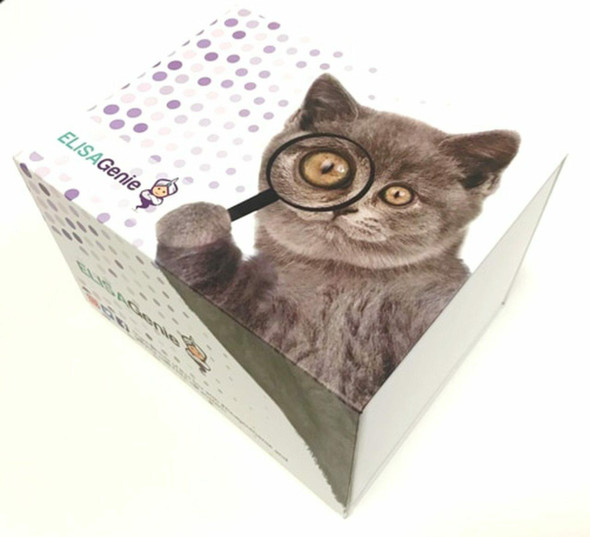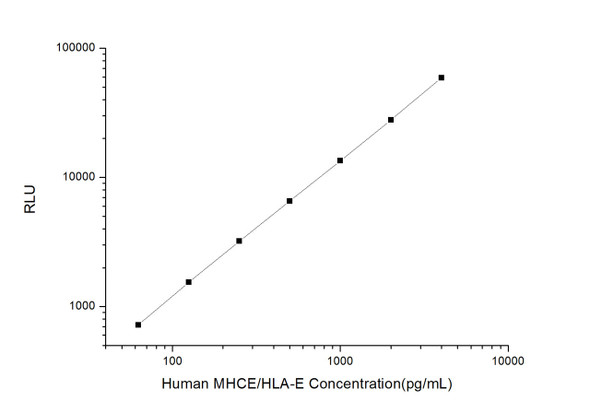Human Immunology ELISA Kits 1
Human MHCC/HLA-C (Major Histocompatibility Complex Class I C) CLIA Kit (HUES01207)
- SKU:
- HUES01207
- Product Type:
- ELISA Kit
- ELISA Type:
- CLIA Kit
- Size:
- 96 Assays
- Sensitivity:
- 37.5pg/mL
- Range:
- 62.5-4000pg/mL
- ELISA Type:
- Sandwich
- Synonyms:
- MHC-C, HLA-JY3, HLC-C, PSORS1, D6S204
- Reactivity:
- Human
- Sample Type:
- Serum, plasma and other biological fluids
- Research Area:
- Immunology
Description
| Assay type: | Sandwich |
| Format: | 96T |
| Assay time: | 4.5h |
| Reactivity: | Human |
| Detection method: | Chemiluminescence |
| Detection range: | 62.50-4000 pg/mL |
| Sensitivity: | 37.50 pg/mL |
| Sample volume: | 100µL |
| Sample type: | Serum, plasma and other biological fluids |
| Repeatability: | CV < 15% |
| Specificity: | This kit recognizes Human MHCC/HLA-C in samples. No significant cross-reactivity or interference between Human MHCC/HLA-C and analogues was observed. |
This kit uses Sandwich-CLIA as the method. The micro CLIA plate provided in this kit has been pre-coated with an antibody specific to Human MHCC/HLA-C. Standards or samples are added to the appropriate micro CLIA plate wells and combined with the specific antibody. Then a biotinylated detection antibody specific for Human MHCC/HLA-C and Avidin-Horseradish Peroxidase (HRP) conjugate are added to each micro plate well successively and incubated. Free components are washed away. The substrate solution is added to each well. Only those wells that contain Human MHCC/HLA-C, biotinylated detection antibody and Avidin-HRP conjugate will appear fluorescence. The Relative light unit (RLU) value is measured spectrophotometrically by the Chemiluminescence immunoassay analyzer. The RLU value is positively associated with the concentration of Human MHCC/HLA-C. The concentration of Human MHCC/HLA-C in the samples can be calculated by comparing the RLU of the samples to the standard curve.
| UniProt Protein Function: | HLAC iso7: Involved in the presentation of foreign antigens to the immune system. Belongs to the MHC class I family. |
| UniProt Protein Details: | Protein type:Membrane protein, integral; Receptor, misc. Chromosomal Location of Human Ortholog: 6p21. 3 Cellular Component: cell surface; early endosome membrane; endoplasmic reticulum; Golgi apparatus; Golgi membrane; MHC class I protein complex; phagocytic vesicle membrane; plasma membrane Molecular Function:antigen binding; peptide antigen binding Biological Process: antigen processing and presentation; antigen processing and presentation of exogenous peptide antigen via MHC class I, TAP-dependent; antigen processing and presentation of exogenous peptide antigen via MHC class I, TAP-independent; antigen processing and presentation of peptide antigen via MHC class I; regulation of immune response |
| NCBI Summary: | HLA-C belongs to the HLA class I heavy chain paralogues. This class I molecule is a heterodimer consisting of a heavy chain and a light chain (beta-2 microglobulin). The heavy chain is anchored in the membrane. Class I molecules play a central role in the immune system by presenting peptides derived from endoplasmic reticulum lumen. They are expressed in nearly all cells. The heavy chain is approximately 45 kDa and its gene contains 8 exons. Exon one encodes the leader peptide, exons 2 and 3 encode the alpha1 and alpha2 domain, which both bind the peptide, exon 4 encodes the alpha3 domain, exon 5 encodes the transmembrane region, and exons 6 and 7 encode the cytoplasmic tail. Polymorphisms within exon 2 and exon 3 are responsible for the peptide binding specificity of each class one molecule. Typing for these polymorphisms is routinely done for bone marrow and kidney transplantation. Over one hundred HLA-C alleles have been described [provided by RefSeq, Jul 2008] |
| UniProt Code: | P10321 |
| NCBI GenInfo Identifier: | 84028168 |
| NCBI Gene ID: | 3107 |
| NCBI Accession: | P10321. 3 |
| UniProt Secondary Accession: | P10321,O78061, O78083, Q29631, Q29652, Q29867, Q29990 Q95463, Q95603, Q9MY31, Q9TQP9, |
| UniProt Related Accession: | P30499,P30501,P30504,P30505,Q07000,Q29865,Q29960,Q95604,P04222,P30508 |
| Molecular Weight: | 40,649 Da |
| NCBI Full Name: | HLA class I histocompatibility antigen, Cw-7 alpha chain |
| NCBI Synonym Full Names: | major histocompatibility complex, class I, C |
| NCBI Official Symbol: | HLA-C |
| NCBI Official Synonym Symbols: | MHC; HLAC; HLC-C; D6S204; PSORS1; HLA-JY3 |
| NCBI Protein Information: | HLA class I histocompatibility antigen, Cw-1 alpha chain |
| UniProt Protein Name: | HLA class I histocompatibility antigen, Cw-7 alpha chain |
| UniProt Synonym Protein Names: | MHC class I antigen Cw*7 |
| Protein Family: | HLA class I histocompatibility antigen |
| UniProt Gene Name: | HLA-C |
| UniProt Entry Name: | 1C07_HUMAN |
As the RLU values of the standard curve may vary according to the conditions of the actual assay performance (e. g. operator, pipetting technique, washing technique or temperature effects), the operator should establish a standard curve for each test. Typical standard curve and data is provided below for reference only.
| Concentration (pg/mL) | RLU | Average | Corrected |
| 4000 | 55887 62275 | 59081 | 59046 |
| 2000 | 26482 29236 | 27859 | 27824 |
| 1000 | 14514 12454 | 13484 | 13449 |
| 500 | 6362 6848 | 6605 | 6570 |
| 250 | 3306 3180 | 3243 | 3208 |
| 125 | 1582 1580 | 1581 | 1546 |
| 62.50 | 734 776 | 755 | 720 |
| 0 | 34 36 | 35 | -- |
Precision
Intra-assay Precision (Precision within an assay): 3 samples with low, mid range and high level Human MHCC/HLA-C were tested 20 times on one plate, respectively.
Inter-assay Precision (Precision between assays): 3 samples with low, mid range and high level Human MHCC/HLA-C were tested on 3 different plates, 20 replicates in each plate.
| Intra-assay Precision | Inter-assay Precision | |||||
| Sample | 1 | 2 | 3 | 1 | 2 | 3 |
| n | 20 | 20 | 20 | 20 | 20 | 20 |
| Mean (pg/mL) | 213.59 | 630.82 | 1886.59 | 223.47 | 649.71 | 1780.21 |
| Standard deviation | 24.61 | 68.57 | 199.60 | 21.56 | 49.12 | 193.33 |
| C V (%) | 11.52 | 10.87 | 10.58 | 9.65 | 7.56 | 10.86 |
Recovery
The recovery of Human MHCC/HLA-C spiked at three different levels in samples throughout the range of the assay was evaluated in various matrices.
| Sample Type | Range (%) | Average Recovery (%) |
| Serum (n=5) | 84-99 | 91 |
| EDTA plasma (n=5) | 89-104 | 95 |
| Cell culture media (n=5) | 86-98 | 92 |
Linearity
Samples were spiked with high concentrations of Human MHCC/HLA-C and diluted with Reference Standard & Sample Diluent to produce samples with values within the range of the assay.
| Serum (n=5) | EDTA plasma (n=5) | Cell culture media (n=5) | ||
| 1:2 | Range (%) | 99-114 | 96-111 | 86-100 |
| Average (%) | 106 | 102 | 93 | |
| 1:4 | Range (%) | 95-108 | 90-101 | 93-106 |
| Average (%) | 101 | 96 | 99 | |
| 1:8 | Range (%) | 100-117 | 101-119 | 101-119 |
| Average (%) | 107 | 109 | 108 | |
| 1:16 | Range (%) | 93-108 | 89-102 | 88-102 |
| Average (%) | 101 | 96 | 94 |
An unopened kit can be stored at 4°C for 1 month. If the kit is not used within 1 month, store the items separately according to the following conditions once the kit is received.
| Item | Specifications | Storage |
| Micro CLIA Plate(Dismountable) | 8 wells ×12 strips | -20°C, 6 months |
| Reference Standard | 2 vials | |
| Concentrated Biotinylated Detection Ab (100×) | 1 vial, 120 µL | |
| Concentrated HRP Conjugate (100×) | 1 vial, 120 µL | -20°C(shading light), 6 months |
| Reference Standard & Sample Diluent | 1 vial, 20 mL | 4°C, 6 months |
| Biotinylated Detection Ab Diluent | 1 vial, 14 mL | |
| HRP Conjugate Diluent | 1 vial, 14 mL | |
| Concentrated Wash Buffer (25×) | 1 vial, 30 mL | |
| Substrate Reagent A | 1 vial, 5 mL | 4°C (shading light) |
| Substrate Reagent B | 1 vial, 5 mL | 4°C (shading light) |
| Plate Sealer | 5 pieces | |
| Product Description | 1 copy | |
| Certificate of Analysis | 1 copy |
- Set standard, test sample and control (zero) wells on the pre-coated plate and record theirpositions. It is recommended to measure each standard and sample in duplicate. Note: addall solutions to the bottom of the plate wells while avoiding contact with the well walls. Ensuresolutions do not foam when adding to the wells.
- Aliquot 100 µL of standard solutions into the standard wells.
- Add 100 µL of Sample / Standard dilution buffer into the control (zero) well.
- Add 100 µL of properly diluted sample (serum, plasma, tissue homogenates and otherbiological fluids. ) into test sample wells.
- Cover the plate with the sealer provided in the kit and incubate for 90 min at 37 °C.
- Aspirate the liquid from each well, do not wash. Immediately add 100 µL of BiotinylatedDetection Ab working solution to each well. Cover the plate with a plate seal and gently mix. Incubate for 1 hour at 37 °C.
- Aspirate or decant the solution from the plate and add 350 µL of wash buffer to each welland incubate for 1-2 minutes at room temperature. Aspirate the solution from each well andclap the plate on absorbent filter paper to dry. Repeat this process 3 times. Note: a microplatewasher can be used in this step and other wash steps.
- Add 100 µL of HRP Conjugate working solution to each well. Cover with a plate seal andincubate for 30 min at 37 °C.
- Aspirate or decant the solution from each well. Repeat the wash process for five times asconducted in step 7.
- Add 100 µL of Substrate mixture solution to each well. Cover with a new plate seal andincubate for no more than 5 min at 37 °C. Protect the plate from light.
- Determine the RLU value of each well immediately.






